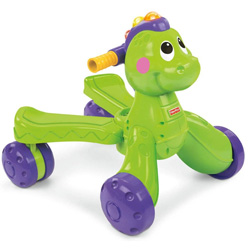Stride to Ride Dino
For learning to walk, then closes to become ride toy
 Stride to Ride Dino Song : You are one of a kind , we were made for each other. Always. This toy is ready to steady baby’s first steps, encouraging progress with rewarding lights, sounds, and upbeat music. Once walking is assured, it easily converts from walker to ride-on. Back wheels come together and the seat locks securely in place, so toddlers can hop on and ride all around. Handles helps baby stand and balance, while the wide wheel base offers sturdy support.
Stride to Ride Dino Song : You are one of a kind , we were made for each other. Always. This toy is ready to steady baby’s first steps, encouraging progress with rewarding lights, sounds, and upbeat music. Once walking is assured, it easily converts from walker to ride-on. Back wheels come together and the seat locks securely in place, so toddlers can hop on and ride all around. Handles helps baby stand and balance, while the wide wheel base offers sturdy support.
The Fascination of Dinosaurs for Babies
Even at a very young age, babies exhibit a natural fascination with dinosaurs that captivates their attention and curiosity. The allure of these ancient creatures is woven into their developmental journey, influencing their sensory experiences and sparking a sense of wonder. Here's why even babies are drawn to dinosaurs:
- Visual Stimulation: The unique and often bold physical characteristics of dinosaurs, such as their large size, sharp teeth, and intricate patterns, provide babies with captivating visual stimuli that attract their gaze and hold their attention.
- Contrasting Shapes: Dinosaurs feature distinct shapes that contrast with the familiar forms in a baby's world. Babies are naturally drawn to novelty, and the unconventional shapes of dinosaurs intrigue and engage their developing cognitive processes.
- Colorful Imagery: Many depictions of dinosaurs showcase vibrant and contrasting colors, which stand out to babies and stimulate their developing sense of color perception and visual discrimination.
- Imaginative Play: Babies engage in imaginative play even from an early age. Toy dinosaurs allow them to explore imaginative scenarios, creating opportunities for storytelling, role-playing, and creative expression.
- Textured Exploration: Babies explore the world through touch, and the textured surfaces of dinosaur toys and books provide tactile experiences that promote sensory exploration and fine motor skills.
- Curious Sounds: The notion of roaring dinosaurs can capture a baby's auditory attention. Babies are attuned to novel and intriguing sounds, and the idea of dinosaurs emitting distinct noises piques their curiosity.
- Engaging Movement: Babies are captivated by movement, and the idea of dinosaurs roaming and interacting in their environment stimulates their innate interest in motion and animation.
- Visual Patterns: The patterns found on the skin or feathers of some dinosaur species create visual patterns that attract a baby's attention and engage their developing pattern recognition abilities.
- Shared Enthusiasm: Babies often respond to the enthusiasm and excitement of those around them. If caregivers or older siblings are interested in dinosaurs, babies are likely to pick up on the positive energy and curiosity.
- Connection to Nature: Dinosaurs bridge the gap between the modern world and the prehistoric past, offering babies a glimpse into a time when Earth was very different. This connection to the natural world sparks their innate wonder and fascination.
The fascination of dinosaurs for babies is a testament to their innate curiosity, sensory exploration, and capacity for imaginative play. The visual, tactile, auditory, and emotional aspects of dinosaurs create a multi-faceted appeal that contributes to their enduring popularity among even the youngest explorers.
